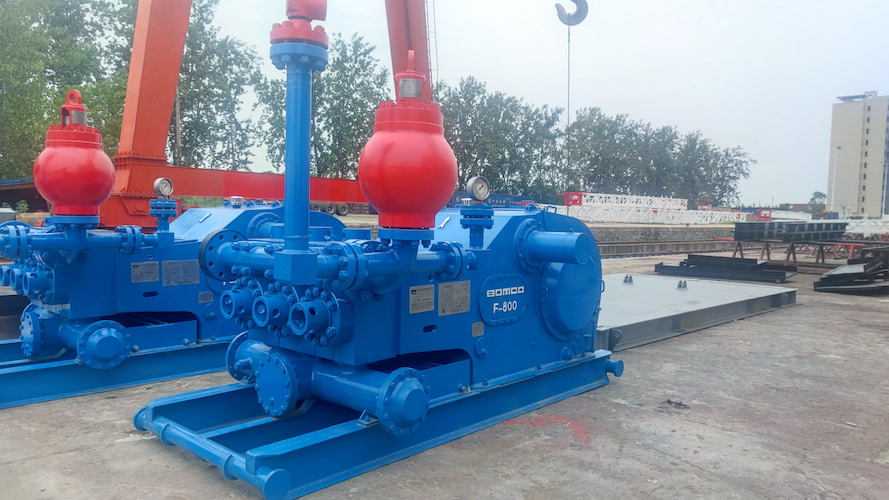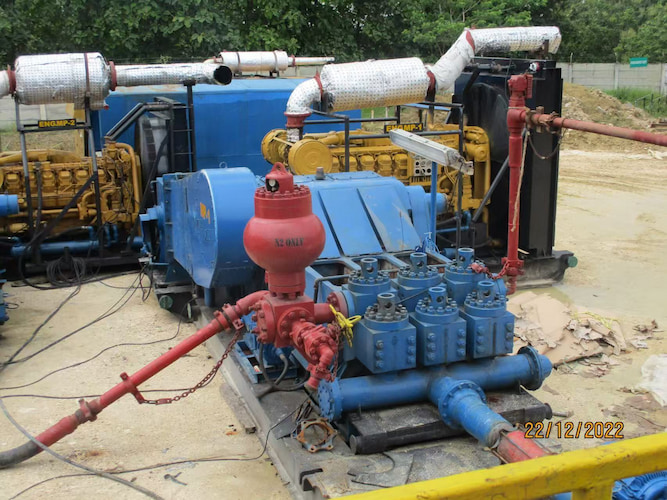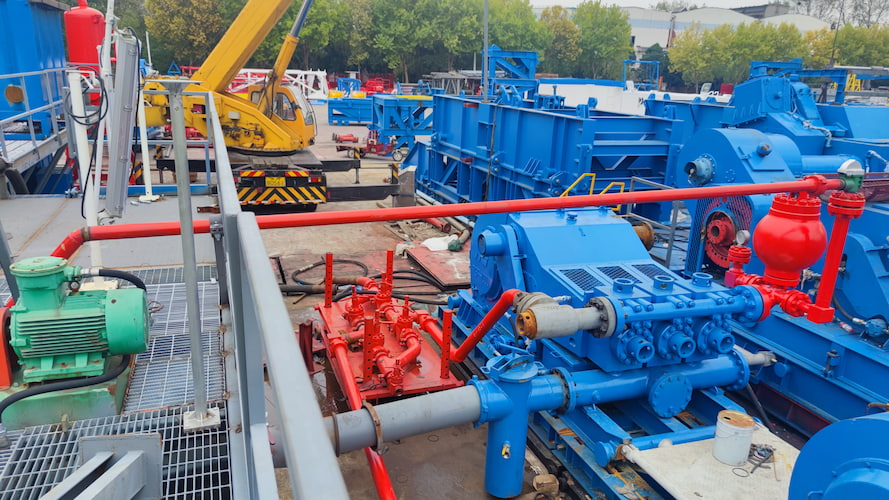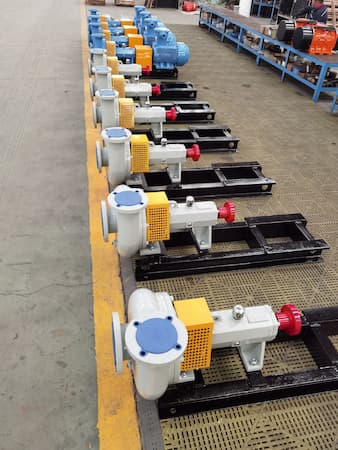What kind of pump is used in drilling rigs?
Feb 19, 2025
There are mainly two types of pumps. One is the mud pump, and the other is the centrifugal pump. The following is a detailed introduction to these two types of pumps.
Ⅰ.Mud Pump
Definition and Working Principle
The mud pump is a vital component of drilling equipment. Its operation is based on the principle of volume change. Through the reciprocating motion of a piston or a plunger inside the cylinder, the volume of the working chamber is changed, enabling the suction and discharge of mud. When the piston or plunger moves backward, the working volume inside the pump cylinder increases, and the pressure decreases. Under the action of the pressure difference, the mud pushes open the suction valve and enters the pump cylinder. When the piston or plunger moves forward, the working volume inside the pump cylinder decreases, and the pressure increases. The mud then pushes open the discharge valve and is forced into the discharge pipeline.
Structural Composition
Power End:It transfers the power of the prime mover (such as an electric motor or a diesel engine) to the hydraulic end, causing the piston or plunger to move in a reciprocating manner. The main components include a pulley or a coupling (which connects the prime mover and the transmission shaft), a transmission shaft (which transmits power to the crankshaft), a crankshaft (which converts the rotational motion into the reciprocating motion of the piston or plunger), a connecting rod (which connects the crankshaft and the crosshead), and a crosshead (which moves back and forth within the slideway and transmits the motion to the piston or plunger).
Hydraulic End:It realizes the suction and discharge of mud and consists of the pump cylinder (the space where the piston or plunger moves), the piston or plunger (which changes the volume of the pump cylinder), the suction valve and the discharge valve (which control the unidirectional flow of mud), the drilling mud pump fluid end module (where the valves are installed and the mud passage is formed), and the air accumulator (installed on the discharge pipeline to reduce the pressure fluctuation of the discharged mud).
Function
This is an extremely crucial pump on the drilling rig. Its core task is to circulate the drilling mud (also known as drilling fluid). The mud flows downward through the drill string, passes through the drill bit, and then returns to the surface. The mud can cool and lubricate the drill bit, carry the cuttings generated by the drill bit's breaking to the surface for removal, and maintain the pressure within the borehole to prevent blowout accidents.
The mud pump is an important part of drilling equipment. According to different classification criteria, there are various types. The following is a detailed introduction to its classification, common models, and functions:
Classification by Working Principle
Piston Mud Pump
Working Principle: It relies on the reciprocating motion of the piston within the pump cylinder to periodically increase and decrease the working volume of the pump cylinder, thus achieving the suction and discharge of mud. When the piston moves outward, the pressure inside the pump cylinder decreases, and the mud enters the pump cylinder through the suction valve under the action of atmospheric pressure. When the piston moves inward, the pressure inside the pump cylinder increases, and the mud is discharged through the discharge valve.
Common Models and Functions:
3NB - 1300 Type,This model is a typical triplex single action piston mud pump with a rated power of 1300 horsepower. It is suitable for medium-depth and deep well drilling operations and can provide sufficient pressure and flow rate for the mud to meet the needs of cooling the drill bit, carrying cuttings, and balancing the formation pressure. Its maximum working pressure can reach 35 MPa, and the flow rate can be adjusted according to the drilling requirements. It is widely used on both onshore and offshore drilling platforms.
F1600 Mud Pump For Drilling Rig: It belongs to a high-power piston mud pump with a rated power of 1600 horsepower. It has high reliability and stability and can adapt to complex geological conditions and large pressure fluctuations. The maximum working pressure can reach 40 MPa, and it can effectively transport high-viscosity and high-density drilling fluids. It is often used in large-scale oil drilling projects.
Plunger Mud Pump
Working Principle: Similar to the piston pump, it also changes the working volume through the reciprocating motion of the plunger in the cylinder to achieve the suction and discharge of mud. However, the plunger has a smaller diameter and a special sealing structure, enabling it to withstand higher pressures.
Common Models and Functions
PZ - 320 Type: The pressure range of this model can reach 320 MPa, meeting the requirements of ultra-high-pressure operations. The flow rate is relatively small but can be precisely adjusted. It is suitable for drilling processes that require fine operations, such as the precise injection of mud in directional drilling, ensuring that the mud is delivered to the designated location according to specific pressure and flow rate requirements.
3DP - 500 Type: It adopts a three-cylinder design and has a high flow rate and pressure output. With a relatively large rated flow rate, the maximum working pressure can reach 50 MPa. It can provide continuous and stable power support for large-scale drilling projects, especially performing well in handling drilling fluids with a high sand content and ensuring the normal operation of the mud circulation system.
Classification by the Number of Cylinders
Single-Cylinder Mud Pump
Working Principle: It has only one cylinder and transports mud through the reciprocating motion of a single piston or plunger.
Common Models and Functions: Due to the relatively unstable output of flow rate and pressure of the single-cylinder mud pump, it is currently less used in large-scale drilling operations. Some small single-cylinder mud pumps may be used in laboratory simulated drilling experiments or small-scale geological exploration projects to provide basic mud circulation for the experimental or exploration process.
Double-Cylinder Mud Pump
Working Principle: It has two cylinders, and the two pistons or plungers work alternately, making the output of flow rate and pressure more stable compared to that of the single-cylinder pump.
Common Models and Functions: Some double-cylinder mud pumps are suitable for some shallow well drilling or small-scale drilling projects, and their pressure and flow rate can meet the basic needs of these projects. Compared with the single-cylinder pump, the double-cylinder pump has certain improvements in work efficiency and stability, but there is still a certain gap compared with mud pumps with three or more cylinders.
Three-Cylinder Mud Pump
Working Principle: The three cylinders are arranged at an angle of 120°. The three pistons or plungers work alternately, making the flow rate output more uniform and the pressure fluctuation smaller.
Common Models and Functions:Common three-cylinder pump models include F-1600, F-2200, F-2500, etc. The three-cylinder pump is a reciprocating pump composed of three plungers and a crankshaft. Compared with the plunger pump, it has a higher flow rate and relatively lower pressure capacity. Commonly used three-cylinder pumps can usually provide a power output of up to 1600 to 2500 horsepower, with a maximum flow rate of 1000 to 2000 gallons per minute, and a maximum working pressure of 6000 to 7500 pounds per square inch. Three-cylinder pumps are usually suitable for deeper well depths, large-diameter boreholes, and drilling operations with larger flow rate requirements.
The selection of these pumps will depend on specific drilling requirements, including well depth, borehole diameter, working pressure, and flow rate requirements, among other factors. When selecting a pump model, it is necessary to evaluate these factors in combination and consult with the supplier according to the technical specifications and requirements of the drilling rig to determine the most suitable pump model. At the same time, it is necessary to ensure that the selected pump can cooperate well with the power system of the drilling rig to achieve stable and efficient drilling operations.
Ⅱ.Centrifugal Pump
The centrifugal pump is a pump that uses the centrifugal force generated by the rotation of the impeller to transport liquids and is also widely used in drilling operations:
Working Principle: The motor drives the impeller to rotate at a high speed, causing the mud to be thrown from the center of the impeller to the outer edge of the impeller under the action of centrifugal force, thereby obtaining energy and being transported out.
Characteristics: It features a simple structure, easy operation, a large flow rate, and a relatively low head. It has certain requirements for the viscosity and impurity content of the mud. It has a relatively high efficiency and relatively low energy consumption.
Application Scenarios: It is mainly used for the circulation, preparation, and transportation of mud, such as transporting the mud from the mud pit to the inlet of the mud pump or transporting the mud in the mud purification system.
The centrifugal mud pump is a special type of centrifugal pump, mainly used for transporting mud, ore pulp, and other media containing solid particles. The following is a detailed introduction to its classification, common models, and functions:
Classification by Impeller Structure
Centrifugal Mud Pump with Closed Impeller
Structural Characteristics: The impeller has cover plates on both sides, and the blades are enclosed between the cover plates. This structure enables the impeller to effectively increase the pressure and speed of the liquid, resulting in relatively high efficiency.
Suitable Media: It is suitable for transporting mud with a relatively low concentration of solid particles and relatively small particle sizes because the flow channel of the closed impeller is relatively narrow, and overly large particles are likely to cause blockages.
Application Scenarios: It is more commonly found in scenarios such as urban sewage treatment and the transportation of ore pulp in small-scale ore dressing plants.
Centrifugal Mud Pump with Open Impeller
Structural Characteristics: The impeller has no cover plates, and the blades are directly installed on the hub. The flow channel is spacious and less likely to be blocked.For example, Mission Type Open Impeller Centrifugal Sand Pump, Mission Type Magnum XP Centrifugal Sand Pump, and Mission Type Sandmaster Centrifugal Pump.
Suitable Media: It can transport mud containing large particles and a high concentration of solids, and it has strong adaptability to the media.
Application Scenarios: It is often used in working conditions such as mine slag discharge and river channel dredging, where the mud has larger particles and a higher content.
Centrifugal Mud Pump with Semi-Open Impeller
Structural Characteristics: The impeller has a cover plate on only one side and combines some characteristics of both the closed and open impellers. Its efficiency is between that of the closed and open impellers, and its anti-blocking ability is also moderate.
Suitable Media: It is suitable for transporting mud containing a certain amount of particles but with relatively small particle sizes and not extremely high concentrations.
Application Scenarios: It is more frequently used in the transportation of ore pulp or coal pulp in some medium-sized ore dressing plants and coal washing plants.
Classification by Pump Body Structure
Single-Stage Single-Suction Centrifugal Mud Pump
Structural Characteristics: It has only one impeller, and the liquid is sucked from one side of the impeller. The structure is simple, and the manufacturing and maintenance costs are relatively low.
Performance Characteristics: The flow rate is relatively small, and the head is generally not too high, but it can meet the needs of some occasions where the requirements for flow rate and head are not particularly high.
Application Scenarios: It is often used for mud discharge in small construction sites, small sewage treatment stations, etc.
Multistage Centrifugal Mud Pump
Structural Characteristics: It is composed of multiple impellers connected in series, and the liquid passes through each impeller in turn, gradually increasing the pressure.
Performance Characteristics: It can obtain a higher head and is suitable for scenarios where the mud needs to be transported over a long distance or where greater resistance needs to be overcome.
Application Scenarios: It is widely used in scenarios such as the discharge of slag from deep mines and the long-distance transportation of ore pulp in large-scale ore dressing plants.
Classification by Pump Installation Method
Horizontal Centrifugal Mud Pump
Structural Characteristics: The pump shaft is arranged horizontally, and the installation and maintenance are relatively convenient, with good stability.
Application Scenarios: It is the most common installation method and is suitable for most fixed installation occasions, such as the mud transportation system in factory workshops.
Vertical Centrifugal Mud Pump
Structural Characteristics: The pump shaft is arranged vertically, and it occupies a small area, making it suitable for installation in places with limited space, such as small collecting wells. For example, LSB Series Vertical Sand Pump
Application Scenarios: It is often used for drainage in underground wells, dredging of small ponds, and other working conditions with limited space.
In addition, both the centrifugal sand pump and the centrifugal mud pump are special types of centrifugal pumps and play important roles in multiple fields. The following is a detailed introduction to their characteristics, working principles, application scenarios, common models, and other aspects:
Ⅲ.Similarities
Working Principle: Both are based on the working principle of the centrifugal pump and rely on the centrifugal force generated by the high-speed rotation of the impeller to transport the medium. Before starting, the pump casing and the suction pipe need to be filled with the medium to be transported. After starting, the prime mover drives the impeller to rotate at a high speed, and the blades drive the medium to rotate together. Under the action of centrifugal force, the medium is thrown from the center of the impeller to the outer edge of the impeller, obtaining kinetic energy and static pressure energy. After the medium enters the pump casing, due to the expansion of the cross-section of the pump casing channel, the flow rate decreases, and part of the kinetic energy is converted into static pressure energy. Finally, the medium enters the discharge pipeline from the discharge port at a relatively high pressure. At the same time, a low-pressure area is formed at the center of the impeller, and under the action of the pressure difference, the medium continuously enters the pump from the suction pipe to achieve continuous transportation.
Basic Structure: Both include main components such as the impeller, the pump casing, the pump shaft, the bearings, and the sealing device. The impeller is the key component for enabling the medium to obtain energy; the pump casing is used to collect and guide the medium; the pump shaft transmits power; the bearings support the pump shaft; and the sealing device prevents the medium from leaking.
Ⅳ.Differences
Characteristics of the Transported Medium
Centrifugal Sand Pump: It is mainly used for transporting liquids containing a large amount of sand grains or other abrasive solid particles. These solid particles have relatively large particle sizes, high hardness, and strong abrasiveness. For example, in scenarios such as river channel sand mining and ore sand transportation, the sand grain content in the medium is high, and the wear on the pump is relatively severe.
Centrifugal Mud Pump: The transported medium is mud, which is a mixed liquid composed of water, clay, additives, and cuttings. The particle sizes of the solid particles are relatively small, and the viscosity of the medium is usually higher than that of the medium transported by the centrifugal sand pump. For example, the mud generated during oil drilling, construction piling, and other processes.
Materials of the Flow-Through Components
Centrifugal Sand Pump: In order to resist the abrasion of sand grains, the flow-through components (such as the impeller and the pump casing) usually adopt high-hardness and high-wear-resistant materials, such as high-chromium alloys. These materials have good wear resistance and impact resistance, which can extend the service life of the pump.
Centrifugal Mud Pump: In addition to considering wear resistance, the flow-through components also need to consider corrosion resistance because the mud may contain various chemical substances. Generally, wear-resistant and corrosion-resistant alloy materials are used, or special treatments are carried out on the surface of ordinary materials to improve their corrosion resistance and wear resistance.
Performance Characteristics
Centrifugal Sand Pump: It usually needs to have a relatively high head and a large flow rate to meet the requirements of long-distance and high-concentration sand grain transportation. However, due to the abrasion of sand grains, the efficiency of the pump may decrease as the running time increases.
Centrifugal Mud Pump: It pays more attention to the adaptability to high-viscosity mud and can maintain a stable flow rate and pressure when transporting high-viscosity media. Its head and flow rate vary according to specific application scenarios. Generally speaking, under the same power, due to the relatively high viscosity of the mud, its flow rate may be smaller than that of the centrifugal sand pump.
Application Scenarios
Centrifugal Sand Pump: It is widely used in fields such as mines, river channel sand mining, marine mining, and coal washing plants. For example, in mines, it is used to transport ore sand from the mine to the ore dressing plant; in river channel sand mining operations, it is used to extract river sand from the riverbed and transport it to the shore.
Centrifugal Mud Pump: It is mainly applied in fields such as oil drilling, construction piling, sewage treatment, and mine tailings treatment. In oil drilling, it is used for circulating the mud, cooling the drill bit, and carrying the cuttings; in the construction piling process, it is used for discharging the mud in the piling holes.
Read More





 Language :
Language : English
English Русский
Русский عربي
عربي
 GET A QUOTE
GET A QUOTE






 IPv6 network supported
IPv6 network supported